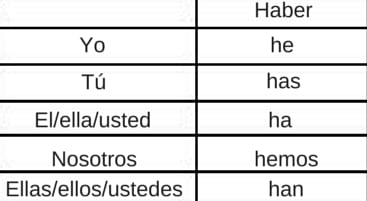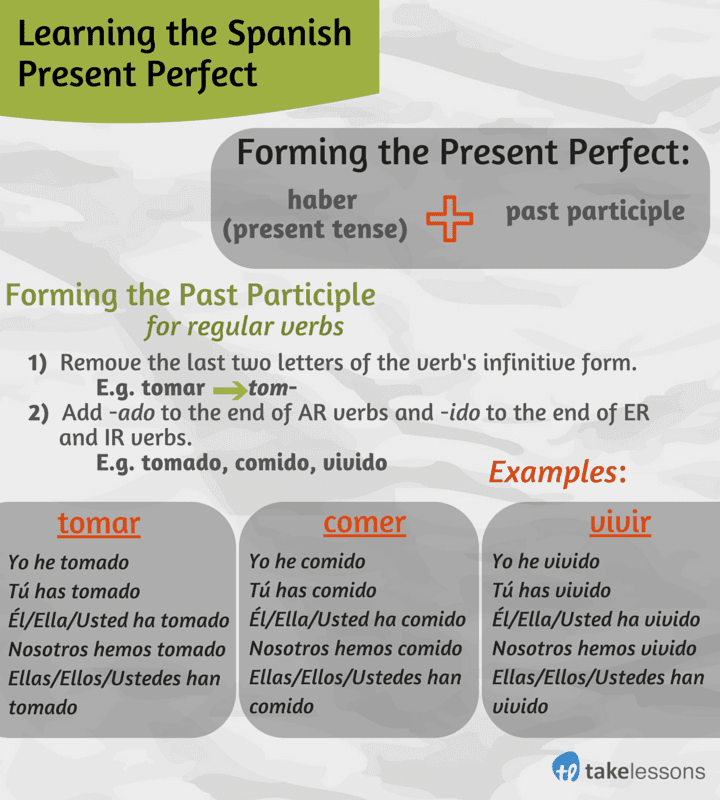Ready for your next lesson in Spanish grammar? Here, tutor Jason N. explains what you need to know about present perfect Spanish conjugations…
Mastering verb conjugation is crucial to learning Spanish. It’s all about knowing patterns and formulas, as I’ve reviewed in some of my earlier posts about Spanish grammar.
If you’re reading this now, it probably means you are well aware of the importance of conjugating verbs to describe situations and events. Conjugations also enable us to form coherent sentences that specify the ‘who,’ ‘what,’ and ‘when’ of a particular action.
By now, you have come a long way. You know how to conjugate basic verbs in the present tense (such as beber, hablar, and escribir), stem-changing verbs in the present conjugation Spanish (such as pedir, poder, and querer), irregular verb conjugations in their ‘yo’ form (such as vengo for the verb venir), and how to conjugate Spanish verbs in the past tense, the imperfect, and the conditional and future tenses.
Next up? Presente perfecto conjugation or The present perfect tense Spanish!
What is the Present Perfect Tense?
While the preterite tense refers to a one-time, isolated event in the past, and the imperfect tense describes past events that occurred in a habitual or routine manner, the Spanish present perfect refers to past actions, events, thoughts, or beliefs that are still happening or are in progress, and are likely to continue into the present (i.e. ‘something has happened’).
All we need to do now is learn a new formula that will make present perfect conjugations so easy that they will become second nature. The present perfect in Spanish is conjugated by using the following formula: haber (in the present tense) + the past participle of a given verb.
Forming the Past Participle
To form the past participle for an -ar verb, there are two simple steps:
- Remove the last two letters of infinite form of the -ar verb (e.g. tomar→tom).
- Add –ado to the end of the verb (e.g. tomado). In this case, tomado translates to the word “taken” in English, which is the past participle of the verb “to take.”
To form the past participle of -er or -ir verbs, you simply add –ido (instead of –ado) to the end of the word, after removing the last two letters of the verb’s ending in the infinitive form (e.g. comer→com→comido).
Forming the Present Perfect
Now that you know how to conjugate the past participle in Spanish, we can add this to the present perfect formula (present tense of haber + past participle of a given verb) to create the present perfect tense. As a reminder, haber is conjugated like this:
As we move on to the next step, let’s start with the example of the verb tomar.
Conjugating -ar Verbs in the Present Perfect
- Create the correct participle. (tomar→tom→tomado = ‘taken’)
- If you are referring to yo or ‘I,’ use he, forming he tomado. (I have taken)
- If you are referring to tú or ‘you,’ use has to form has tomado. (You have taken)
- If you are referring to él or ella or ‘he’ or ‘she,’ use ha to form ha tomado. (He/she has taken)
- If you are referring to nosotros or ‘we,’ use hemos to form hemos tomado. (We have taken)
- If you are referring to ellos or ‘they,’ use the ending han to form han tomado. (They have taken)
Conjugating -er and -ir Verbs in the Present Perfect
As an example, let’s use comer (to eat) to show -ir present perfect and -er present perfect.
- Create the correct participle. (comer→com→comido = ‘eaten’)
- ‘Yo’ would be he comido. (I have eaten)
- If you are referring to tú or ‘you,’ it would be has comido. (You have eaten)
- If you are referring to él or ella or ‘he’ or ‘she,’ use ha comido. (He/she has eaten)
- If you are referring to nosotros or ‘we,’ use hemos comido. (We have eaten)
- If you are referring to ellos or ‘they,’ use han comido. (They have eaten)
Ready for some practice? Conjugate the following in the present perfect tense:
Irregular Past Participles
There are several verbs that have irregular past participle forms. Unfortunately, memorizing these verbs’ past participles is the best way to learn them.
Verbs with the same root as irregular verbs naturally have the same irregularities. Here are a few examples:
- componer – compuesto
- describir – descrito
- devolver – devuelto
Once you memorize the irregulars, which is easier than it sounds (once you practice or study regularly), you’ll be ready to go! Remember: a Spanish tutor can really help if you get stuck!
 Post Author: Jason N.
Post Author: Jason N.Jason N. tutors in English and Spanish in Fairfax, CA. He majored in Spanish at UC Davis, lived in Mexico for 3 years where he completed a Master’s degree in Counseling, and studied Spanish Literature and Psychology at the University of Costa Rica. Learn more about Jason here!
Photo by m00by
Suzy S.






